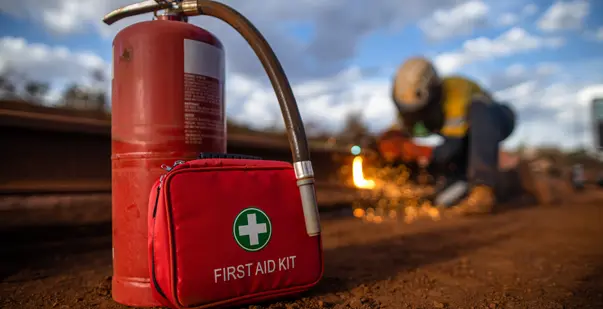Table of content(s)
- What is the general first aid treatment for a chemical burn?
- How should a mild chemical burn on the hand be managed?
- What is the recommended first aid for chemical burns of the eye?
- How should a mild chemical burn on the hand be managed?
- How can a chemical burn blister be treated effectively?
- What are the best practices to prevent chemical burns?
- What is the appropriate treatment for a fertilizer burn on the skin?
Chemical Burns: First Aid Treatment and Prevention Tips
Chemical burns result from exposure to substances like acids, bases, or other corrosive materials. Immediate and appropriate first aid is crucial in preventing them to minimize tissue damage and promote healing.
Understanding the general first aid treatment and prevention tips for chemical burns is essential for individuals who encounter such injuries. This knowledge helps in providing timely care to individuals affected by chemical burns. It also reduces the severity of the injury and improves outcomes. In such emergencies, online first aid and CPR courses can also be life-saving in emergencies.
Let us now explore the first-aid tips for managing chemical burns effectively.
1. What is the general first aid treatment for a chemical burn?
Chemical burns need immediate first aid to prevent further damage. The first aid treatment for a chemical burn includes:
- Removing the chemical by rinsing the affected area under running water for 10 to 20 minutes.
- Seeking medical care promptly.
2. How should a mild chemical burn on the hand be managed?
Managing a mild chemical burn on the hand is crucial for optimal healing. Here’s how to manage a mild chemical burn on the hand:
- Immediately rinse the affected area under cool running water for at least 10 to 15 minutes.
- Cover the burn with a dry, sterile bandage after rinsing.
- Avoid breaking any blisters that may form.
- Consider taking over-the-counter pain medication if necessary.
- Apply a moisturizing lotion, such as aloe vera, once the burn has cooled.
3. What is the recommended first aid for chemical burns of the eye?
For a chemical burn in the eye, immediately flush the eye with clean cool tap water for 15 minutes. This helps neutralize the eye’s pH. If possible, use buffered eyewash solutions. Keep irrigating until the eye’s pH stays neutral for at least 30 minutes after the last rinse. Studies show that prompt irrigation with tap water or specific solutions leads to better ocular and clinical outcomes.
4. How should a mild chemical burn on the hand be managed?
Here are the key steps to manage a mild chemical burn on the hand:
- Immediate Irrigation: Rinse the affected area under cool running water for at least 10-20 minutes to remove the chemical.
- Remove Contaminated Clothing: Take off any clothing or jewelry that may have come into contact with the chemical.
- Apply a Dry Sterile Dressing: Wrap the burned area loosely with a dry sterile dressing or a clean cloth.
- Pain Management: For superficial burns, over-the-counter pain relievers like ibuprofen or acetaminophen can help.
- Seek Medical Attention: If the burn is more serious, such as being larger than 3 inches, on the face or major joints, seek medical help immediately.
Read more: 10 Reasons why you should learn CPR
5. How can a chemical burn blister be treated effectively?
Here are the key points to treat a chemical burn blister:
- Avoid Popping: Avoid breaking the blister to prevent infection and promote healing.
- Clean the Area: Gently clean the blister with non-perfumed soap and water.
- Apply Ointment: Use a simple ointment like petroleum jelly or aloe vera to keep the area moisturized.
- Protect with Dressing: Cover the blister lightly with a sterile nonstick gauze bandage.
- Pain Management: Manage pain with over-the-counter medications like acetaminophen or ibuprofen.
- Seek Medical Attention: If the blister breaks, clean it carefully, apply an antibiotic ointment, and cover it with a sterile bandage.
6. What are the best practices to prevent chemical burns?
To prevent chemical burns effectively, follow these best practices as a part of first aid:
- Proper Handling: Wear protective gear when working with chemicals.
- Adequate Ventilation: Ensure good airflow in areas where chemicals are used.
- Labeling: Clearly label all containers to avoid mix-ups.
- Storage: Store chemicals in a safe and secure location.
- Education: Provide training on safe chemical handling practices.
- Emergency Preparedness: Have an emergency plan in place for chemical spills or accidents.
7. What is the appropriate treatment for a fertilizer burn on the skin?
Here are the key steps in managing a fertilizer burn:
- Immediate Irrigation: Rinse the affected area with cool running water for at least 15 minutes to remove any remaining fertilizer particles.
- Avoid Creams or Lotions: Do not apply creams or lotions unless directed by a healthcare professional to prevent complications.
- Seek Medical Attention: For severe burns, large affected areas, or if there is uncertainty about the extent of the injury, seek medical care promptly.
- Follow-Up Care: Follow any additional instructions by healthcare providers for optimal wound healing and to prevent infections.
Read more: Online CPR Certification: Is It Right for You? A Comprehensive Guide for Busy Professionals
Conclusion
Understanding the appropriate first aid measures for chemical burns is crucial in reducing tissue damage. Immediate rinsing of the affected area, avoiding further exposure, and seeking prompt medical care are the basic steps. By following these guidelines, healthcare professionals can manage chemical burns on the skin, eyes, and hands, and reduce complications.
